Cam Hagen wasn’t born into a fishing family, but he was born into a fishing community, Homer, Alaska, and worked on boats for years before building his own with the help of local businesses. His new boat, a 50-foot seiner named the Phosphorescence, is designed with innovative features that will take it into the future.
“I worked as a deckhand for seven years,” says Hagen. “Then I bought my first boat. I sold that and bought a tender with the intention of getting back to a seiner. Finally, we pulled the trigger on this one.”
First designed to be a 46-foot seiner, Hagen added four feet to the hull and decided to power his vessel with a pair of 625-hp Volvo Penta D11B1-A MP engines with ZF325-1 gears at 3.125:1 and Hill Innovations HI501 jets. While other seiners are being equipped with jets, Hagen believes he may be the first out of the gate.
Hagen says the idea was to have a boat that was not outdated in ten years: “Things are always changing.”
"We hoped we could build it in one winter," he says. "But overall, it took 15 months. We fished about two-thirds of the 2023 season." Hagen notes that building a boat is a collaborative effort, and he is indebted to many local companies, as well as members of his family and community.
Starting with the design, Hagen created a foam model of the boat he wanted and took it to Brad Conley at Bay Weld Boats in Homer, Alaska, where he used to work. "Brad created the files for the sides and bottom for a 48-footer. I’m eternally grateful to him because without him it would have been much harder." That was in 2019. Hagen sat on the files for almost two years before finally sending them to be cut in 2021. He had settled on a 50’x18.5’ shallow draft twin-jet seiner/tender, but adding four feet to the boat meant he and the team at Alaska Metal Works (AKMW) in Homer had to fill in the blanks, as well as design the deck and wheelhouse.
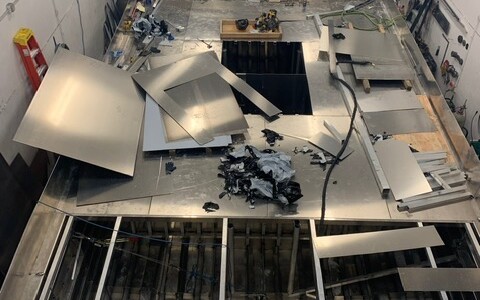
"It was originally intended to be a jitney boat, a small seiner that fishes up in stream mouths and shallow water, but we decided that a boat like that might not have the same value as a regular seiner if we had to sell. We ended up with the shallow draft of a jitney — there’s only four and a half inches of deadrise from the keel to the chine — but more of a regular seiner, though not a limit seiner."
At Alaska Metal Works, Johnny Kraning, Leo Cooper, Titus McGhee, Ian Taylor, and Hagen built the bulkheads and framing, and welded on the aluminum plate. "We used 5086, 1/4-inch on the bottom," says Hagen. "And 5086 3/16 on the side walls and deck." The AKMW crew also added a 3/8-inch double skin to the 1/4-inch transom. "To protect it from the seine skiff banging against it," says Hagen. To protect the hull, Danny Buckwalter at North West Signs and vinyl put a vinyl skin on the boat. "It’s kind of holographic," Hagen says. "Which goes great with the boat because the boat is named Phosphorescence."
For power, Hagen opted for the pair of 625-hp Volvo Penta D11s, ZF gears, and Hill jets previously mentioned. "I went with the Volvos because after asking around and doing my research they were the best-priced engine for horsepower I could get." Hagen bought the Volvo Pentas and worked with Pacific Power Group and In-Demand Marine on many of his engine and gear needs. "I went with the Hill 501 jets because I have seen Jason Hill’s jets in action and I know what they can do," says Hagen, noting that having worked with Jason on previous projects, he was confident in getting good customer service. "I could have gone with a different power package," he says. "But this really fit the bill as far as the kind of boat I was envisioning."
Hagen positioned the jets as deep into the hull as he could get them, to avoid getting the net tangled in them. "AKMW welded the transom to the very most aft side of the jet housing, pushing the jet further into the engine room compartment," says Hagen. "Next, we added doubler plates to the jet housing and made a reverse chute that falls directly in line with the jet when the bucket is down and in full reverse." According to Hagen, this forces all the water for the jet forward when in reverse. "Other boats have done this, but where AKMW did it differently is our chutes are about 2.5-feet long," he says.
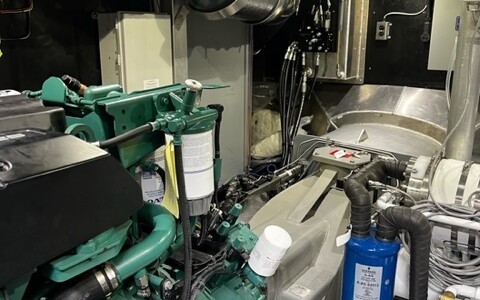
To run the hydraulics, the Phosphorescence has two FluiDyne 35/45 pumps jackshaft driven via Pitts electric clutches from main engines. "We worked with Desperate Marine here in Homer and set up pumps so both could feed into the system or it could run on just one in case you have a breakdown, which we did." The hydraulic system drives the deck gear, the seine block, winches, and also two cranes. "They’re for tendering," says Hagen. "I bought them used from Trident and got them rebuilt at Desperate Marine."
For seining, Hagen has an 8-inch aluminum pipe main boom fit with stainless steel hydraulic tubing, a Rotzler TH2 topping winch, vang winches, and a 26-inch Marco seine block with a gripper wheel. "We fish a full-depth seine," says Hagen. "Three strips. It’s a little much but so far we haven’t had any trouble. Bullet Proof Nets, which is now owned by LFS, made it."
AKMW added another innovation on the picking booms for the seine and for tendering. "We have three winches on each picking boom, two to bring in fish and one for raising and lowering the picking boom," says Hagen. "Normal picking booms have pulleys and cleats and you usually have to climb up to adjust them. These picking booms are hydraulic power for adjustment up and down, much like a main boom with a topping winch."
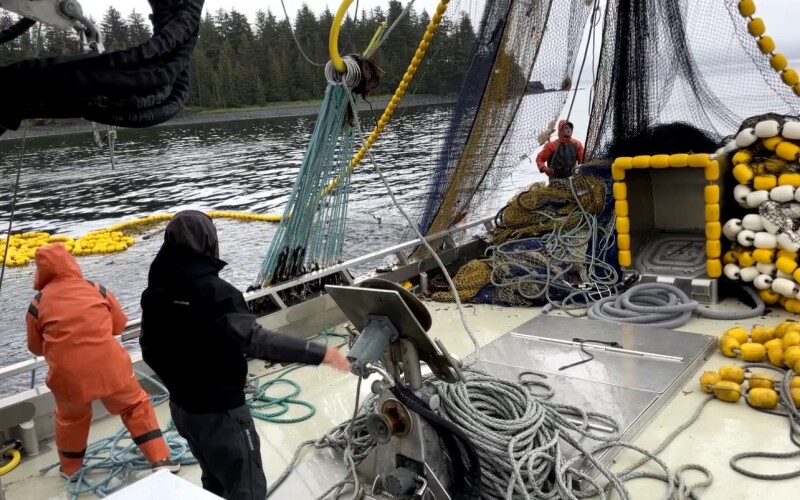
The mast has a crow’s nest for spotting fish, and AKMW made it enclosed. "We did a lot of things different," says Hagen. "The entryway to the wheelhouse goes through the free-standing mast and actually makes it stronger, Brad Conley did that design. We enclosed the crow’s nest so you don’t mind being up there when the weather’s bad." According to Hagen, the idea was to get ahead on design and have a boat that was not outdated in ten years. "Things are always changing," he says.
Besides two Volvo Pentas, the Phosphorescence also has a 35kW Northern Lights genset that powers the crew accommodations and a 20-ton IMS refrigerated seawater (RSW) system to chill the catch. "The boat holds 93,000 pounds," says Hagen. "It’s got two fish holds, the forward one holds 56,000 , the aft one holds 37,000. I just have the one divider, no baffles. I can run a slack tank with no problem. We fish mostly in Prince William Sound; if we fished Kodiak it might be different."
Hagen usually fishes with a crew of three or four, besides himself, sometimes more when his wife and four children come along. "The boat can sleep eight," says Hagen. "There are four bunks in the bow, the settee in the galley can turn into a double bunk, and there’s a double bunk in the wheelhouse. When the kids are there, they all sleep on the floor and the baby with my wife and me."
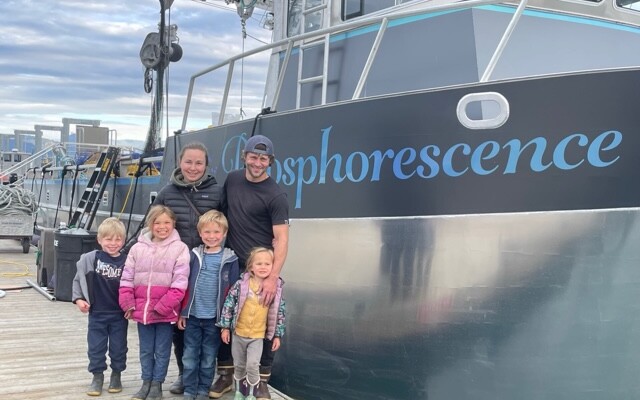
The Phosphorescence wheelhouse is unique in that there is no wheel. "It has a new Glendinning steering system. I have a joystick and jog lever," says Hagen. "With the joystick, I can twist it, power ahead, reverse. I use the steering lever and engine controls, but the joystick can override those."
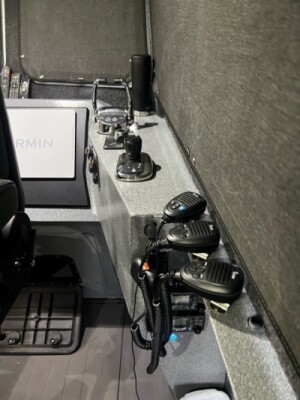
The Phosphorescence electronics package includes three Icom M330G VHFs and an Icom M510 with a command microphone in the crow’s nest. "We went with Garmin for the radar, plotter, and down sounder," says Hagen. "And we have side-viewing down sounders, but we didn’t have them ready this past season."
The Phosphorescence also has Garmin Reactor 40 Autopilot, a Victron Energy Cerbo GX remote battery monitor, Fusion Wi-Fi, Sirius XM satellite stereo with flush-mounted speakers. John Larson of Alaska Marine Electrical in Homer did all the wiring on the boat, including lighting in the fish hold and innovative deck lighting. "We put lights down in the hold because the deck lights never shine all the way in there," says Hagen. "I didn’t want the guys to have to go down there with headlamps. And we put light under the rails that shine on the deck, and you don’t need big bright lights blinding you. And they’re good for when you’re moving and you don’t want to attract a lot of attention."
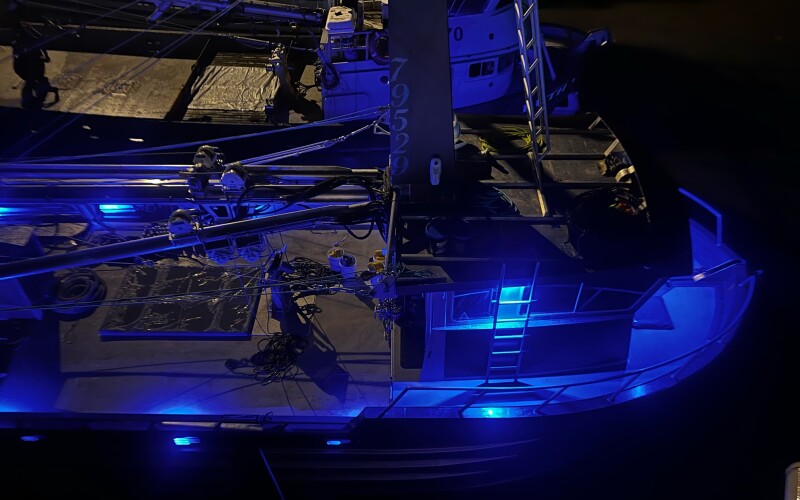
Phosphorescence fished its first season in Prince William Sound this year, and like the rest of the fleet, had to deal with terrible prices. "We were above average," says Hagen. "My younger brother had a good season. We didn’t do as good as him. I got beat by my little brother, and I’m proud of him."
With its unique design and myriad innovations, the Phosphorescence will undoubtedly attract attention, even when running at night with low-profile deck lights.







